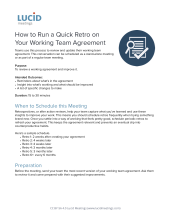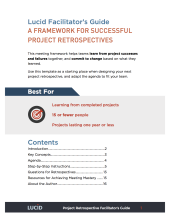You can find an introduction to Action Review Meetings in Chapter 20 of Where the Action Is. These resources will help you plan, run, and troubleshoot the specific Action Review Meetings your team needs.
Definition
An Action Review Meeting is used by teams to learn from experience and use what they've learned to improve future work.
Questions Answered
- What was our plan?
- What did we learn?
- What should we change in our approach going forward?
Examples
- Project and Agile Retrospectives
- After Action Reviews and Before Action Reviews (Military)
- Pre-Surgery Meetings (Healthcare)
- Win/Loss Review (Sales)
- Design Critiques, Charettes (Design & Architecture)
Core Process
Most action review meetings follow a process that includes these steps.
- What? What happened or What are we planning?
- So what? What do we think and feel about this situation?
- Now what? What should we do next?
Purpose
- Learning: gain insight.
- Develop confidence.
- Generate recommendations for change.
Work Outcomes
- Process improvement.
- Increased team efficiency.
- Improved operational performance.
Human Outcomes
- Shared commitment to quality.
- Continuous learning and individual skill improvement.
- Deepened connection to the shared mission and each other.
Meeting Agenda Templates and Guides
How to Run a Quick Retro on Your Working Team AgreementElise Keith - Teams use this process to review and update their working team agreement. This conversation can be scheduled as a stand-alone meeting or as part of a regular team meeting. |
|
How to Run a Successful Project RetrospectiveElise Keith - This meeting agenda template helps teams learn from project successes and failures together, and commit to change based on what they learned. Use this template as a starting place when designing your next project retrospective, and adapt the agenda to fit your team. |
Recommended Reading & Resources
Articles
- A Better Approach to After-Action Reviews, Angus Fletcher, Preston B. Cline, and Matthew Hoffman (2023)
- "Learning from Success and Failure", Bob Sutton (2007).
- "Learning in the Thick of It", Marilyn Darling, Charles Parry, Joseph Moore (2005).
Blog Posts
- "Etsy’s Debriefing Facilitation Guide for Blameless Postmortems", John Allspaw (2016).
Books
- Agile Retrospectives: Making Good Teams Great. Esther Derby, Diana Larsen (2006).
Podcast
- Podcast: This is Retrospective Facilitation hosted by Enrico Teotti
Websites
- Awesome Retrospectives, a GitHub repository of resources
- Wildland Fire Leadership Council AAR Resources.
Glossary of Meeting Terms
Technique
The 4Ls technique is a brainstorming technique for collecting feedback on a recently completed project or piece of work. People in the meeting are asked to brainstorm feedback in four categories: things they Liked,...
Circles and Soup is an exercise teams use to the identify the parts of their work they can control directly, the factors they can influence, and those which are outside of their control. Once these factors are sorted...
The Peaks and Valleys exercise gives groups a simple visual way to share each person's unique view on the highs and lows of an experience. Groups use this exercise to help visualize events over time and see how each...
PMI is a brainstorming technique for gathering feedback on an idea, concept, or when a team takes a retrospective look at a recently completed set of work. After introducing the idea, the group is asked to write...
Stop, Start, Continue is an exercise used to evaluate a group's activities and make decisions about which ones to prioritize going forward. Steps include:
Step 1: Setup
Create three blank lists labeled Start,...
Meeting Type
An After-Action Review lays out a structured de-briefing process for analyzing an event. Participants discuss what happened, why it happened, and what can be done better in the future. After-Action Reviews were...
A Post Mortem, in the context of meetings, is a process usually conducted at the conclusion of a project to determine which parts of the project were successful or unsuccessful. Project post-mortems are intended to...
A Pre-Mortem is a meeting before a project starts in which a team imagines what might happen to cause a project to fail. The team then works backward to create a plan to help prevent potential obstacles and increase...
A retrospective is a meeting that's held at the end of an iteration in Agile software development or at the completion of a project. During the retrospective, the team reflects on what happened in the iteration and...

